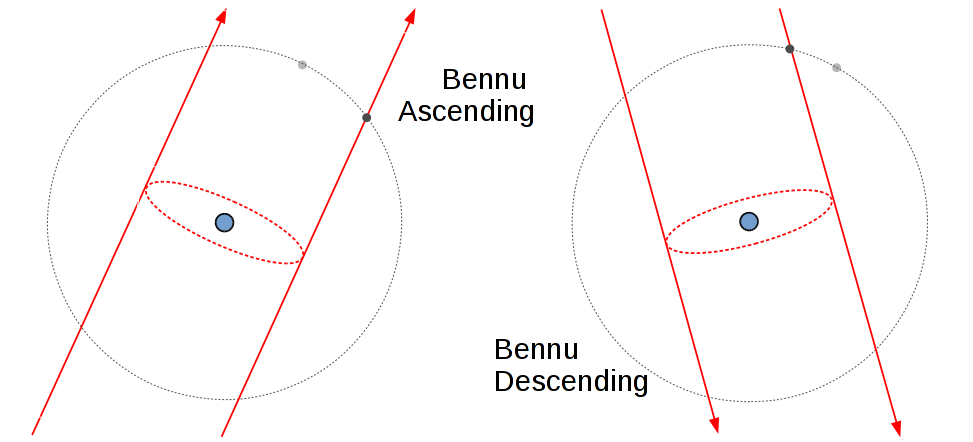|
Size: 6073
Comment:
|
Size: 6145
Comment:
|
| Deletions are marked like this. | Additions are marked like this. |
| Line 30: | Line 30: |
That is illustrated below as "Bennu Descending" ... towards the Sun. |
Intercepting Bennu
101955 Bennu is a 500 meter diameter Near Earth Asteroid, likely to crash into the Earth sometime in the next 20,000 years, and possibly sooner than 200 years from now. The impact energy would be equivalent to a 100 megaton bomb, or 4 times the explosive energy of the Mount Saint Helens eruption. That won't be a global catastrophe, but it could kill millions of people if it impacted in the wrong place.
Bennu is an Apollo asteroid, with a semimajor axis of 1.1264 AU and an eccentricity of 0.20375. It will make a close approach of 750,000 km on 23 September 2060, and another of 300,000 ± 200,000 km on 25 September 2135. The uncertainty results from small variations of arrival distance creating larger variations in the scattering angle after the 2060 encounter.
I am unable to calculate an accurate model of Bennu's orbit, nor whether it will arrive "inbound" or "outbound", or which side of the Earth the miss will occur. However, I have enough information to calculate the relative velocity (5 km/s) and the angle from the Sun ( 13 degrees ). How?
The 2060 and 2135 encounters both are about 100 days before Earth's perihelion on January 4th 2061 and January ?? 2136. That lets us calculate Earth's radial distance from the Sun (1.0029 AU), hence the radius of Bennu at that close approach. Given the radius and Bennu's orbit, we can compute Bennu's angle from perihelion, 1.1858 radians ( 67.94 degrees ).
At that angle, Bennu's radial velocity (sunwards or outwards?) is ±5.143 km/s, and the circumferential velocity is 30.860 km/s, relative to the Earth's radial velocity of -0.490 km/s (sunwards) and circumferential velocity of 29.703 km/s. So, the radial velocity difference is -0.490∓5.143 km/s, either 5.903 km/s inwards (-) or 4.923 km/s outwards. I'd like to know, but the results will be similar either way.
The circumferential velocity difference will be the same; Bennu will approach from "behind" the Earth with a relative velocity of 30.860 - 29.703 or 1.156 km/s in the direction of Earth's (and Bennu's orbit), though it might miss to the front or miss to the back (not enough information).
The vector sum of those velocities is either 6.016 or 5.057 km/s, which is the "v∞" of the encounter. The angle from inwards towards the Sun would be 11 degrees, if the trajectory was outwards, 13 degrees from solar zenith. The trajectory would be deflected somewhat towards the Earth, and so the outgoing angle would differ a little from those numbers, depending on the side of the Earth that the close approach happens.
If this led to the collision, the Earth's 11.18 km/s escape velocity would be vector summed with v∞; the result would be an impact velocity of 12.696 or 12.271 km/s. For 70 million tonne Bennu, that is a kinetic energy equivalent of a 106 or a 103 MT bomb.
But Bennu is likely to miss in both 2060 and 2135, and all I know about the miss is that it will pass through a circle perpendicular to Bennu's path, radius 750,000 km in 2060 and perhaps 300,000 km in 2135 (perhaps 63 Bennu "years" later).
Hitting the Moon?
Before I did this calculation, I had hoped that the 2135 near miss could be arranged to impact the Moon, which will be three days after full on 25 September. The Moon (in a 384,000 km orbit) will be about 37 degrees or 200,000 km east of zenith at that time.
It turns out ...
That if the nominal 2135 closest approach is instead 141191 km, and the Moon would be exactly 36 hours after full Moon at that time, that the positions of Bennu and the Moon will coincide exactly - a collision. Of course, Bennu is unlikely to be coplanar, and the unperturbed radial miss could be in any radial direction from the Earth normal to the velocity vector; I will need a better description of Bennu's actual three dimensional trajectory to make this claim. Still, it shows that it is possible (with some artificial deflection before the 2060 close approach, to deliver Bennu into the side of the Moon, preferably the far side.
That is illustrated below as "Bennu Descending" ... towards the Sun.
Calculations
Earth |
Bennu |
|
|
7.00E+10 |
kg Mass |
1 |
1.1264 |
AU Semimajor axis |
149597900 |
168507075 |
km Semimajor axis |
1 |
1.1954 |
year Period |
365.2422 |
436.64 |
day Period |
0.0167086 |
0.20375 |
eccentricity |
29.790 |
28.666 |
km/s v0 |
1.0167 |
1.3559 |
AU aphelion |
0.9833 |
0.8969 |
AU perihelion |
|
100 |
degrees from perihelion, close approach earth orbit angle |
1.00290 |
1.00290 |
AU Close approach radius |
|
1.07651 |
1+ecos() |
1.7453 |
1.1858 |
radians at close approach |
29.703 |
30.860 |
km/s circumferential velocity |
-0.490 |
±5.413 |
km/s radial velocity |
if Beppu orbits |
|
|
outwards |
inwards |
|
-1.156 |
-1.156 |
km/s circumferential difference |
-5.903 |
-4.923 |
km/s radial difference |
11.08 |
13.22 |
degrees velocity angle from radial |
6.016 |
5.057 |
km/s total relative velocity |
11.180 |
11.180 |
km/s Earth escape velocity |
12.696 |
12.271 |
km/s Earth impact velocity |
4.44E+17 |
4.29E+17 |
Joules impact kinetic energy |
|
4.18E+15 |
Joules per megatonne TNT |
106 |
103 |
MT TNT equivalent |

